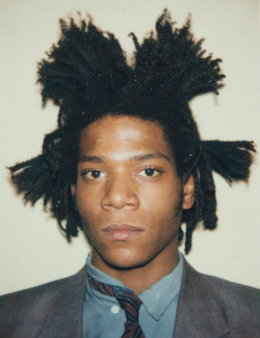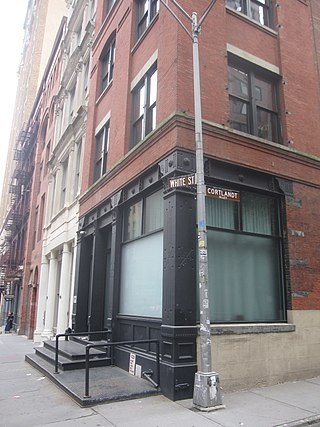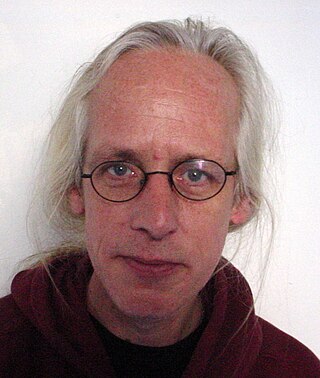New York/New Wave was an exhibition curated by Diego Cortez in 1981. Held at the Long Island City gallery P.S.1, it documented the crossover between the downtown art and music scenes. The show featured a coalition of No wave musicians, painters, graffiti artists, poets, and photographers.
The New Wave was a brief underground art and music post-punk pop art scene based around lower Manhattan that reflected the pulse of the late 1970s. [1] By the early 1980s, the interest in it had transitioned from the streets into the art galleries of downtown New York. In June 1980, Colab's The Times Square Show , held in an abandoned multi-story massage parlor on 41st Street and Seventh Avenue, set the precedent as "the first radical art show of the eighties." [2]
Diego Cortez, co-founder the Mudd Club, a venue for underground music and counterculture events, united the downtown scene for a group exhibition titled New York/New Wave. [3] The show held at P.S.1 in Long Island City, Queens from February 15 to April 5, 1981. [4]
The show featured over 100 participants, including Ray Johnson, Lawrence Weiner, William S. Burroughs, Andy Warhol, Jean-Michel Basquiat, Keith Haring, Fab Five Freddy, Futura 2000, Kenny Scharf, Stephen Sprouse, Christopher Makos, Duncan Hannah, Maripol, Marcus Leatherdale, William Coupon, Bob Gruen, Kate Simon and Edo Bertoglio. [5] [6] The walls were covered with works of different media hung side by side. The show opened up the New York art scene to the then 20-year-old Basquiat, who participated under the alias of his graffiti tag SAMO. [5] [7]
John Perreault of the SoHo Weekly News was dumbfounded that the show was a huge hit: "Why so many people? Is the art world eager for a possible new wave slap in the face?" [8] He found it "a plain and timid thing" and mocked the "New Wave" title by calling exhibition a "tidewrack." [8]
Glenn O'Brien took a jibe at Perreault's review in his article for Interview magazine. "This is a tidal wave of art, about to reduce the entire art world to limp rubble, particularly the stuff that floats." [8] He continued: "Here's a whole new art world ready to replace the old one. Of course the old one is not going to just pack up and move to Chicago because of an art show in Long Island City. But I can tell they're scared. And why? I think because here is art based on life, not on art. The public might like it." [8]

Jean-Michel Basquiat was an American artist who rose to success during the 1980s as part of the Neo-expressionism movement.
No wave was an avant-garde music genre and visual art scene that emerged in the late 1970s in Downtown New York City. The term was a pun based on the rejection of commercial new wave music. Reacting against punk rock's recycling of rock and roll clichés, no wave musicians instead experimented with noise, dissonance, and atonality, as well as non-rock genres like free jazz, funk, and disco. The scene often reflected an abrasive, confrontational, and nihilistic world view.

Fred Brathwaite, more popularly known as Fab 5 Freddy, is an American visual artist, filmmaker, and hip hop pioneer. He is considered one of the architects of the street art movement. Freddy emerged in New York's downtown underground creative scene in the late 1970s as a graffiti artist. He was the bridge between the burgeoning uptown rap scene and the downtown No Wave art scene. He gained wider recognition in 1981 when Debbie Harry rapped on the Blondie song "Rapture" that "Fab 5 Freddy told me everybody's fly." In the late 1980s, Freddy became the first host of the groundbreaking hip-hop music video show Yo! MTV Raps.

Downtown 81 is a 2000 American film that was shot in 1980-1981. The film was directed by Edo Bertoglio and written and produced by Glenn O'Brien and Patrick Montgomery, with post-production in 1999-2000 by Glenn O'Brien and Maripol. It is a rare real-life snapshot of an ultra-hip subculture of post-punk era Manhattan. Starring renowned artist Jean-Michel Basquiat and featuring such East Village artists as James Chance, Amos Poe, Walter Steding, Tav Falco and Elliott Murphy, the film is a bizarre elliptical urban fairy tale. In 1999, Michael Zilkha, founder of ZE Records, became the film's executive producer.

The Mudd Club was a nightclub located at 77 White Street in the TriBeCa neighborhood of Lower Manhattan in New York City. It operated from 1978 to 1983 as a venue for post punk underground music and no wave counterculture events. It was opened by Steve Mass, Diego Cortez and Anya Phillips.
Maripol is an artist, film producer, fashion designer and stylist. She has had an influence on the looks of influential artists such as Madonna and Grace Jones. As part of the 1980s New York downtown scene, she captured the likes of Jean-Michel Basquiat, Keith Haring, Andy Warhol, and Debbie Harry with her Polaroid camera. Maripol also produced films, most notably Downtown 81.
Edo Bertoglio is a Swiss photographer, film director and screenwriter. He is the director of Downtown 81 and Face Addict.
Michael Thomas Holman is a New York-based artist, writer, filmmaker and musician. He is also an early 1980s downtown scene subculturalist and creator of the Hip Hop music program Graffiti Rock. Holman is a founding member, along with Jean-Michel Basquiat, of the experimental band Gray.

Patricia Titchener, known by her stage name Patti Astor, was an American performer who was a key actress in New York City underground No Wave films of the late-1970s. Astor was a key player in the East Village art scene of the early-1980s as she co-founded the instrumental contemporary art gallery, Fun Gallery. Astor also was involved in the early popularizing of hip hop with her performance in Wild Style.

Glenn O'Brien was an American writer who focused largely on the subjects of art, music, and fashion. He was featured for many years as "The Style Guy" in GQ magazine and published a book with that title. He worked as a writer and editor at a number of publications, including Rolling Stone, Playboy, Interview, High Times, Spin, and Details. He also published the arts and literature magazine Bald Ego from 2003 to 2005.

Carlo McCormick is an American culture critic and curator living in New York City. He is the author of numerous books, monographs and catalogues on contemporary art and artists.
SAMO is a graffiti tag originally used on the streets of New York City from 1978 to 1980. The tag, written with a copyright symbol as "SAMO©", and pronounced Same-Oh, is primarily associated with the artist Jean-Michel Basquiat, but was originally developed as a collaboration between Basquiat and Al Diaz.
Jimmy DeSana was an American artist, and a key figure in the East Village punk art and New Wave scene of the 1970s and 1980s. DeSana's photography has been described as "anti-art" in its approach to capturing images of the human body, in a manner ranging from "savagely explicit to purely symbolic". DeSana was close collaborators with photographer Laurie Simmons and writer William S. Burroughs, who wrote the introduction to DeSana's self-published collection of photographs Submission. His work includes the album cover for the Talking Heads album More Songs about Buildings and Food as well as John Giorno’s LP, You’re The Guy I Want To Share My Money With.

Jean-Michel Basquiat: The Radiant Child is a 2010 documentary film directed by Tamra Davis. It crosscuts excerpts from Davis' on-camera interview with the artist Jean-Michel Basquiat and anecdotes from his friends and associates. The film was shown at the Sundance Film Festival in 2010.

Don Leicht was a visual artist who worked as a painter and sculptor in the Bronx, New York City for over forty years. Leicht had one person exhibitions in New York, Sweden and (Germany) and was an early figure in the New York City downtown scene in the 1970s, and in the subsequent Street Art and Graffiti movements.

James Allan Curtis, known professionally as Diego Cortez, was an American filmmaker and art curator closely associated with the no wave period in New York City. Cortez was the co-founder of the Mudd Club, and he curated the influential post-punk art show New York/New Wave, which brought the then aspiring artist Jean-Michel Basquiat to fame.

Robert Hawkins is an American artist born in Sunnyvale, California, USA and presently lives in London, UK., Hawkins' is best known for his "ferocious" style of realism. His first drawing in a publication appeared in the kid's section of the San Francisco Chronicle at the age of 5.
Gray is an American experimental band formed by artist Jean-Michel Basquiat and filmmaker Michael Holman in 1979, of whom filmmaker Vincent Gallo was also a member. The group was influenced by the members' artist backgrounds and the sonic experimentation of their contemporaries in New York's No Wave scene. Gray performed at venues such as the Mudd Club and CBGB which were the epicenter of New York's underground scene in the late 1970s and early 1980s.
The Fun Gallery was an art gallery founded by Patti Astor and Bill Stelling in 1981. The Fun Gallery had a cultural impact until it closed in 1985. As the first art gallery in Manhattan's East Village, it exposed New York to the talents of street art by showcasing graffiti artists like Fab 5 Freddy, Futura 2000, Lee Quiñones, Zephyr, Dondi, Lady Pink, and ERO. Contemporary artists Kenny Scharf, Jean-Michel Basquiat, and Keith Haring also had solo exhibitions at the Fun Gallery.
Annina Nosei is an Italian-born art dealer and gallerist. Nosei is best known for being Jean-Michel Basquiat’s first art dealer and providing him with studio space in the basement of her gallery. From 1981 to 2006, the Annina Nosei Gallery represented or exhibited work by artists such as Barbara Kruger, Robert Longo, Ghada Amer, and Shirin Neshat.